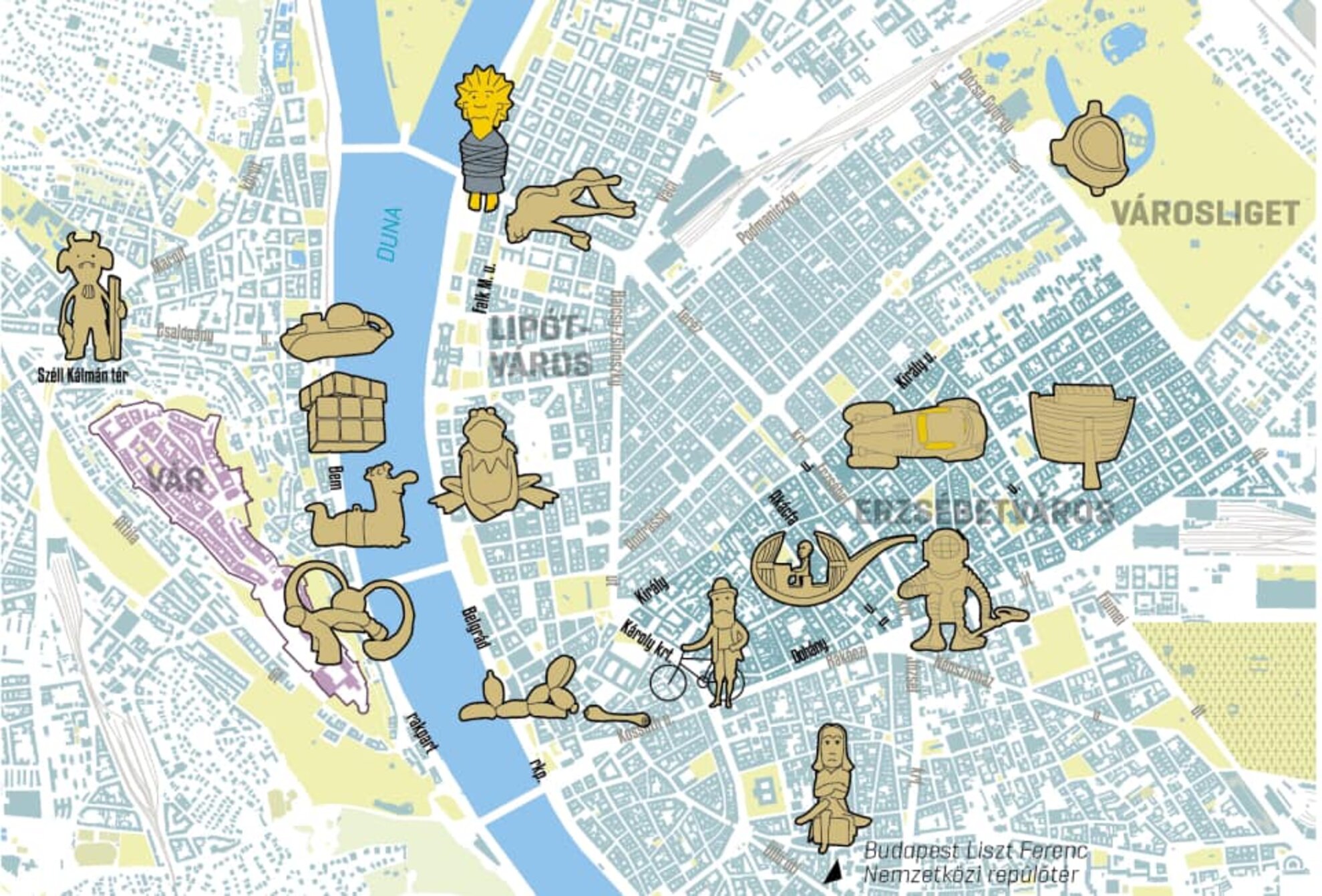Insider’s Guide: Kolodko's Strange Small Statues Around Budapest
- 14 Jun 2023 6:02 PM

Good to know about Kolodko's Small Statues
Many of Kolodko’s creations relate to personalities only Hungarians would know – often a cartoon character from children’s TV – so if you’re taking an offbeat tour to track down his pieces, it might be a good idea to do a little research beforehand.
Some are embedded deep in the Hungarian psyche, a figure such as Süsü the Dragon giving rise to catch phrases still in common parlance today.
Although you may not understand the dialogue, a peruse of a few clips on YouTube also gives you the chance to see how skilled Hungarian animation was back in the 1970s and 1980s.
What are Kolodko statuettes?
The charming statuettes by sculptor Mihály Kolodko offer an alternative take on a story or a legend, in miniature form. They usually raise a smile and invariably prompt a selfie.
To take a universally recognised example, where gallery-lined Falk Miksa utca meets Jászai Mari tér, a life-sized statue of the TV detective Columbo has long stood in place, looking puzzled in his shabby raincoat as he tries to figure out his current case.
The connection between the location and the character is in the Hungarian name ‘Falk’, referring to the famous actor and the street he now occupies in Budapest.
One morning in 2018, Budapest was abuzz with rumour. Another statuette had been left by Kolodko, this time of a gun-toting squirrel with a line drawn around him like a crime scene. Now the detective really does have a crime to solve, as the creature was killed where he fell, and someone needs to figure out who did it.
This is classic Kolodko: funny, slightly mysterious yet crediting the viewer with enough intelligence that they will get the joke and cotton on to the situation.
Other figures require a certain knowledge of Budapest urban history, such as the diver who is bringing up a key. Left beside the New York Café, a historic coffeehouse now also a hotel, this refers to the famous quote by playright Ferenc Molnár, a regular at the original New York of the 1890s, who vowed he would throw the key to the establishment into the Danube so that it would never close.
Who created Kolodko statues and when?
Mihály Kolodko was born into a Hungarian community in Uzhhorod, just over the border in Ukraine. As a child, he would have grown up around Hungarian TV and folk tales, but as a Ukrainian citizen initially, he had a different, perhaps more rounded, take on local culture.
As a sculptor, he graduated from the renowned Lviv Academy of Arts, then came to Hungary. Deciding to think small rather than recreate the kind of monumental works he was responsible for in Lviv, he began to place his small figurines around Budapest.
Initially, it was very word-of-mouth, not unlike guerrilla muralist Banksy in the UK, but these pieces were much more gentle, with a backstory that connected across generations.
By the mid- to late 2010s, it was obvious who he was, and so he would present his creative process on his Facebook page. Not only that, he began to receive commissions, from District VII, for example, delighted for people to explore the neighbourhood to find the diver outside the New York Café or the musician who composed the song ‘Gloomy Sunday’ at the former restaurant where he once had a residency.
Where are the Kolodko statues?
Everywhere!
You’ll find Kermit the Frog near the American Embassy on Szabadság tér, composer Franz Liszt outside Budapest Airport that takes his name and Mr Bean’s teddy bear, fixed to the side of the former British Embassy on Harmincad utca.
While not all are site-specific, there’s no mistaking the symbolism of placing a tank on Bem rakpart, immediately facing Parliament, a reference to the failed Hungarian Uprising of 1956.

What else should I know about the Kolodko Statues?
The figures are sometimes hard to find, and you’ll have to root around a little sometimes. The connections aren’t always obvious to non-Hungarians – not every culture that has a cartoon goat adorably inept at everything he tries to fix – but when you grab or download a map to these figures, there should be write-ups as to who or what they represent.
Kolodko has not only left his mark in Budapest. Visit Vác, a town 40 minutes north of the capital, and you’ll see the figure of Habsburg Empress Maria Theresa beside Hungary’s only triumphal arch. Legend has it that when she was invited to its official unveiling, she refused to walk under the arch for fear it would fall down. Kolodko captures her somewhat trepidatious features perfectly.
To sum up, why visit Kolodko statues?
Everyone loves an offbeat site, and there’s little more offbeat than the works of Mihály Kolodko. Irreverent, quirky yet containing an element of truth, they allow the visitor to explore parts of Budapest they otherwise might not, and to delve into strange yet charming corners of Hungarian culture otherwise closed to the outside world.
The figures are also child-friendly, so the whole family can enjoy a trek around the city without the need to bribe the little ones with ice cream putting up with yet another palace or museum.
Words by Peterjon Cresswell
Peterjon has been researching the byways of Budapest for 30 years, extending his expertise across Europe to produce guidebooks for Time Out and his own website liberoguide.com
Related links



























LATEST NEWS IN getting around